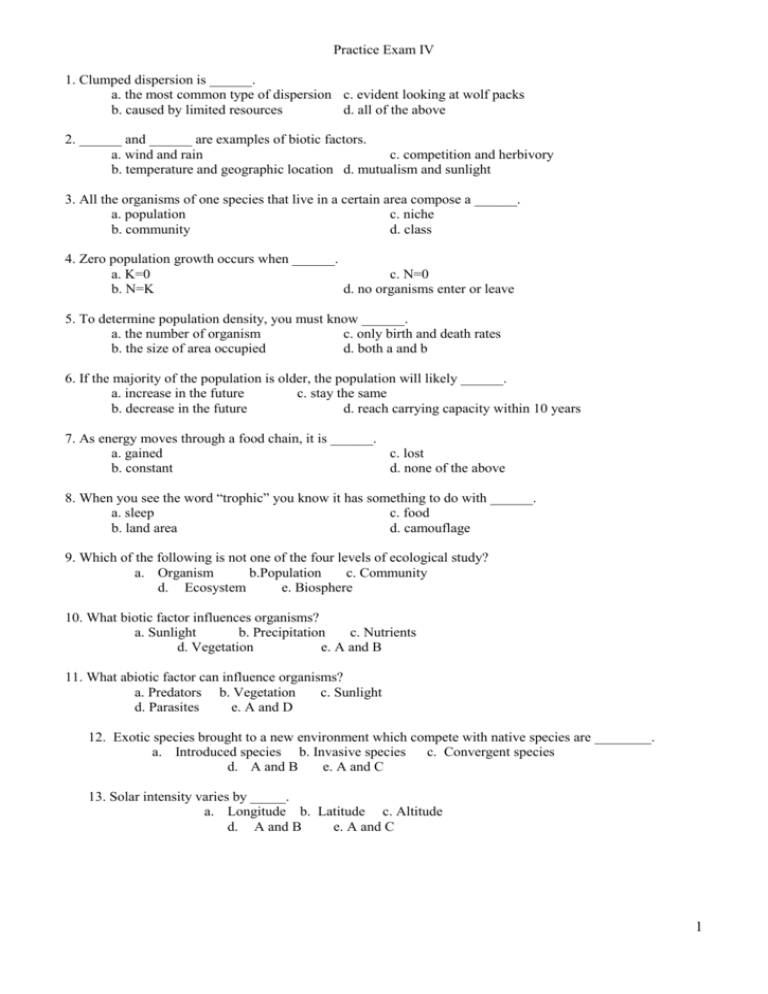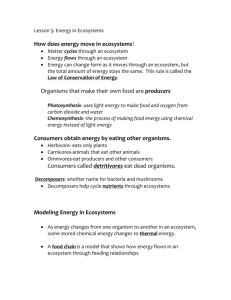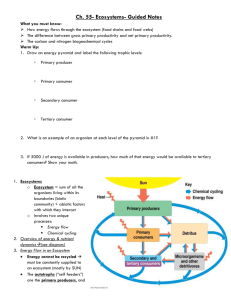Practice Exam IV
advertisement

Practice Exam IV 1. Clumped dispersion is ______. a. the most common type of dispersion c. evident looking at wolf packs b. caused by limited resources d. all of the above 2. ______ and ______ are examples of biotic factors. a. wind and rain c. competition and herbivory b. temperature and geographic location d. mutualism and sunlight 3. All the organisms of one species that live in a certain area compose a ______. a. population c. niche b. community d. class 4. Zero population growth occurs when ______. a. K=0 c. N=0 b. N=K d. no organisms enter or leave 5. To determine population density, you must know ______. a. the number of organism c. only birth and death rates b. the size of area occupied d. both a and b 6. If the majority of the population is older, the population will likely ______. a. increase in the future c. stay the same b. decrease in the future d. reach carrying capacity within 10 years 7. As energy moves through a food chain, it is ______. a. gained c. lost b. constant d. none of the above 8. When you see the word “trophic” you know it has something to do with ______. a. sleep c. food b. land area d. camouflage 9. Which of the following is not one of the four levels of ecological study? a. Organism b.Population c. Community d. Ecosystem e. Biosphere 10. What biotic factor influences organisms? a. Sunlight b. Precipitation c. Nutrients d. Vegetation e. A and B 11. What abiotic factor can influence organisms? a. Predators b. Vegetation c. Sunlight d. Parasites e. A and D 12. Exotic species brought to a new environment which compete with native species are ________. a. Introduced species b. Invasive species c. Convergent species d. A and B e. A and C 13. Solar intensity varies by _____. a. Longitude b. Latitude c. Altitude d. A and B e. A and C 1 14. Which regions have no change in day length over the course of a year? a. Temperate b. Arctic c. Coastal d. Tropic e. None of the above 15. Which of the following does NOT affect species dispersal? a. Behavioral patterns b. Dispersal timing c. Climate d. Predators e. All of the above affect species dispersal 16. What drives heat transfer from tropics to the poles? a. Global air circulation b. Solar energy c. Climate shifting d. Ocean currents e. Abiotic factors 17. Which of the following determines the climate of a region? a. Solar energy b. Ocean currents c. Convection d. Longitude e. Community structure 18. Basic ecology examines ___. a. Species dispersal b. Human impact c. Conservation d. Environmentalism e. Habitat restoration 19. What contributes to seasonality of a region? a. Earth’s tilt b. Earth’s revolution c. Equinoxes d. Longitude e. Earth’s rotation 20. An ecosystem that covers a broad region is a ___. a. Biosphere b. Biome c. Climate d. Tundra e. community 21. Which of the following is FALSE? a. Warm air rises b. Warm air has a greater ability to hold water c. Warm air cools as it rises d. Descending air absorbs moisture e. Atmospheric air holds more water than air near Earth 22. One species in a given space and time is called a ___. a. Population b. Community c. Ecosystem d. Biome e. Biosphere 2 23. What is the effect of artificial selection on microevolution by always harvesting the “best”? a. Drive production of better phenotypes b. Drive production of worse phenotypes c. Drive production for fit individuals d. Drive production for unfit individuals e. Drive speciation 24. Which of the following is not an example of intraspecific interactions? a. Predation b. Competition c. Mating d. Disease e. None of the above 25. Which of the following dispersion patterns do wolves normally display? a. Clumped b. Random c. Uniform d. Bilateral e. Symmetrical 26. Which of the following dispersion patterns do penguins normally display? a. Clumped b. Random c. Uniform d. Bilateral e. Symmetrical 27. Which of the following dispersion patterns do dandelions normally display? a. Clumped b. Random c. Uniform d. Bilateral e. Symmetrical 28. What is the study of factors that will change a population’s size through space and time? a. Ecology b. Population ecology c. Demography d. Census e. Mark and recapture 29. Why do the tropics and the windward side of mountains receive more rainfall than areas around 30 degrees latitude or the leeward side of a mountain? a. rising air expands, cools, and drops its moisture b. descending air condenses and drops its moisture c. the tropics and the windward side of mountains are closer to the ocean d. there is more solar radiation in the tropics and on the windward side of mountains e. the rotation of Earth determines global wind patterns 30. In a population in which offspring survival is quite low and the environment is inconsistent, one might expect a. the production of a small number of large offspring b. the production of a large number of large offspring c. iteroparity or repeated reproduction with a small number of offspring d. semelparity or big-bang reproduction e. more k-selected traits 31.The middle of the S-shaped growth curve in the logistic growth model a. shows that at middle densities, individuals of a population do not affect each other b. is best described the term rN c. is the point where population growth begins to slow due to the Allee effect d. is the period when competition for resources is the highest e. is the period when the population growth rate is the highest 3 32.Which of the following would not be a density-dependent factor limiting a population’s growth? a. increased specialization by a predator b. a limited number of available nesting sites c. a stress syndrome that alters hormone levels d. a very early fall frost e. intraspecific competition 33. A palatable (good-tasting) prey species may defend against predation by a. Mullerian mimicry b. Batesian mimicry c. secondary compounds d. aposematic coloration e. either a or b 34. Which of the following organisms is mismatched with its accompanying trophic level? a. algae-producer b. phytoplankton- primary consumer c. fungi- decomposer d. carnivorous fish larvae- secondary consumer e. eagle- tertiary or quaternary consumer 35. Primary production a. is equal to the standing crop of an ecosystem b. is limited by light, nutrients, and moisture in all ecosystems c. is the amount of light energy converted to chemical energy per unit time in an ecosystem d. is inverted in some aquatic ecosystems e. is all of the above 36. Which of the following is absolutely essential to the functioning of an ecosystem? a. producers and primary consumers b. producers and secondary consumers c. primary, secondary, and tertiary consumers d. primary consumers and detritivores e. producers and detritivores 37. Which of the following is an accurate statement about ecosystems? a. energy is recycled through the trophic structure b. energy is usually converted from sunlight by primary producers, passed to secondary producers in the form of organic compounds, and lost to detritivores in the form of heat c. chemicals are recycled between the biotic and abiotic sectors, whereas energy makes a one-way trip through the food web and is eventually dissipated as heat d. there is a continuous process by which energy is lost as heat, and chemical elements leave the ecosystem through runoff e. a food web shows that all trophic levels may feed off of each other 38. The open ocean and tropical rain forest are the two largest contributors to Earth’s net primary production because: a. both have high rates of net primary production b. both cover huge surface areas of Earth c. nutrients cycle rapidly in these two ecosystems d. the ocean covers a huge surface area and the tropical rain forest has a high rate of production e. both a and b are correct 4 39. Production in terrestrial ecosystems is affected by a. temperature b. light intensity c. availability of nutrients d. availability of water e. all of the above 40. Which of the following is the most serious threat to biodiversity? a. competition from introduced species b. commercial harvesting c. habitat destruction d. overexploitation e. disruptions of community dynamics 41. The focus of the declining-population approach to conservation is to a. predict a species’ minimum viable population size b. transplant members from other populations to increase genetic variation c. perform a population viability analysis to predict the long-term viability of a population in a particular habitat d. determine the cause of a species’ decline and take remedial action e. establish zoned reserves that ensure that human landscapes surrounding reserves support the protected habitats 42. With limited resources, conservation biologists need to prioritize their efforts. Of the following choices, which should receive the greatest conservation attention in order to preserve biodiversity? a.the northern spotted owl b. declining keystone species in a community c. a commercially important species d. endangered and threatened vertebrate species e. all declining species 5









